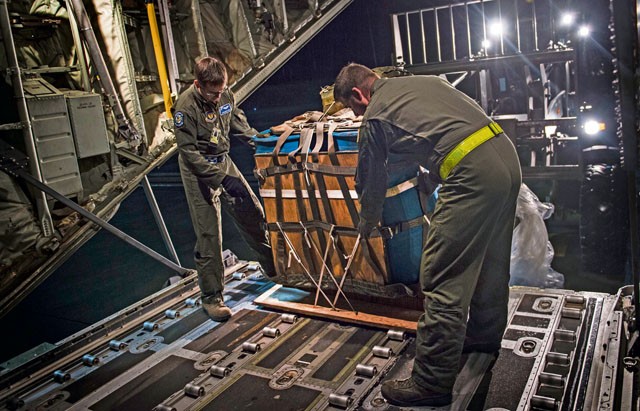
Loadmasters from the 37th Airlift Squadron load water onto an 86th Airlift Wing C-130J Super Hercules Nov. 25 on Ramstein. The water was used to simulate supplies being airdropped during a training mission over Grafenwoehr, Germany.
Airmen hurriedly slipped on their gloves to shield any exposed skin from the white, chilled needles falling from the colorless, late-November sky.
“Wind just hit three knots; it’s looking good,” one said to the other with an optimistic smile. “It should be here soon.”
Like a well-rehearsed play, a faint growl arose from above the low-hanging clouds. “There it is!”
A military cargo plane emerged, and as it passed, parachutes gracefully descended, possibly containing food, water, or clothing — hope to those below.
While this time it was only training bundles that landed for the Airmen, the drop zone at U.S. Army Garrison Grafenwoehr, Germany, is
where the 37th Airlift Squadron goes to practice and evaluate airdrop capabilities to ensure the success of real-world missions.
“During the winter, we have to fly higher to avoid any obstruction in the air, which requires a larger drop zone,” said Capt. Eric Liard, 37th AS pilot. “Grafenwoehr is perfect because it has one of the largest drop zones in Germany, which gives pilots and loadmasters flexibility to work on our skills year-round.”
Conducting airdrops is a way to drop cargo or paratroopers out the back of an aircraft and parachute into an area. This eliminates the need for a runway since the aircraft does not need to land, which is ideal when a delivery needs to be made in a hostile area.
However, providing this capability requires the 37th AS Airmen to be up to date with their certifications, which can be challenging due to Germany’s flight restrictions.
“We are required to fly higher during our low-level operations in Germany compared to the U.S. and other parts of Europe,” said Capt. Bryce Johnson, 37th AS pilot. “We are also unable to train during quiet hours, which are from 10 p.m. to 6 a.m. weekends and during holidays. Even though our time in air is limited, we have another way to stay current with our training.”
Ramstein is home to the only U.S. C-130J Super Hercules simulator in Europe, allowing the Airmen to practice their skills and techniques in a virtual environment.
“Having this asset is phenomenal for the C-130 community here,” Johnson said. “It allows us to do additional training we can’t always accomplish in the local area.”
Taking advantage of these resources allows the 37th AS team an ample opportunity to grow in their skills as well as help develop neighboring militaries.
“Training like we do gives us the credibility to work with our European allies and build our partner’s capacity,” Liard said. “By training together, we solidify our skills to deliver hope in real time, all the time.”
Through sun, rain, snow or sleet, the 37th AS Airmen strive to better themselves and work with their allies to deliver not only supplies but also hope to those in need around the world.


